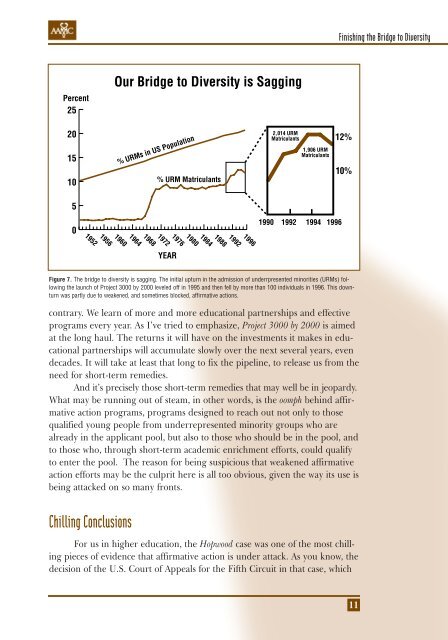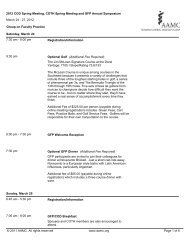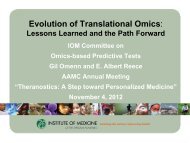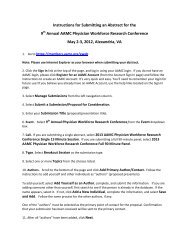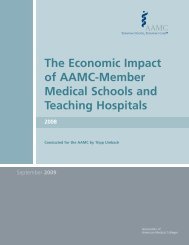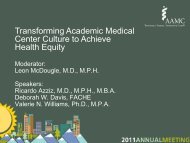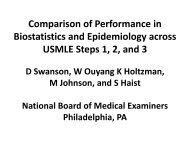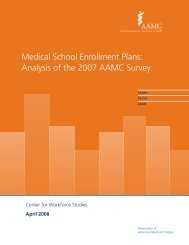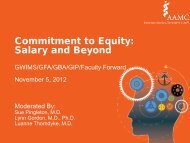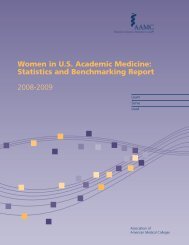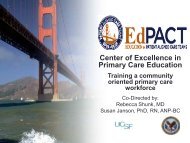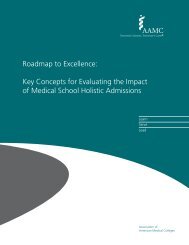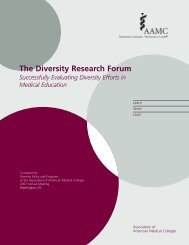Finishing the Bridge to Diversity - Member Profile - AAMC
Finishing the Bridge to Diversity - Member Profile - AAMC
Finishing the Bridge to Diversity - Member Profile - AAMC
Create successful ePaper yourself
Turn your PDF publications into a flip-book with our unique Google optimized e-Paper software.
<strong>Finishing</strong> <strong>the</strong> <strong>Bridge</strong> <strong>to</strong> <strong>Diversity</strong><br />
Percent<br />
25<br />
Our <strong>Bridge</strong> <strong>to</strong> <strong>Diversity</strong> is Sagging<br />
20<br />
15<br />
10<br />
% URMs in US Population<br />
% URM Matriculants<br />
2,014 URM<br />
Matriculants<br />
1,906 URM<br />
Matriculants<br />
12%<br />
10%<br />
5<br />
1972<br />
1968<br />
1964<br />
1960<br />
1956<br />
1952<br />
1996<br />
1992<br />
1988<br />
1984<br />
1980<br />
1976<br />
0<br />
1990 1992 1994 1996<br />
YEAR<br />
Figure 7. The bridge <strong>to</strong> diversity is sagging. The initial upturn in <strong>the</strong> admission of underrpresented minorities (URMs) following<br />
<strong>the</strong> launch of Project 3000 by 2000 leveled off in 1995 and <strong>the</strong>n fell by more than 100 individuals in 1996. This downturn<br />
was partly due <strong>to</strong> weakened, and sometimes blocked, affirmative actions.<br />
contrary. We learn of more and more educational partnerships and effective<br />
programs every year. As I’ve tried <strong>to</strong> emphasize, Project 3000 by 2000 is aimed<br />
at <strong>the</strong> long haul. The returns it will have on <strong>the</strong> investments it makes in educational<br />
partnerships will accumulate slowly over <strong>the</strong> next several years, even<br />
decades. It will take at least that long <strong>to</strong> fix <strong>the</strong> pipeline, <strong>to</strong> release us from <strong>the</strong><br />
need for short-term remedies.<br />
And it’s precisely those short-term remedies that may well be in jeopardy.<br />
What may be running out of steam, in o<strong>the</strong>r words, is <strong>the</strong> oomph behind affirmative<br />
action programs, programs designed <strong>to</strong> reach out not only <strong>to</strong> those<br />
qualified young people from underrepresented minority groups who are<br />
already in <strong>the</strong> applicant pool, but also <strong>to</strong> those who should be in <strong>the</strong> pool, and<br />
<strong>to</strong> those who, through short-term academic enrichment efforts, could qualify<br />
<strong>to</strong> enter <strong>the</strong> pool. The reason for being suspicious that weakened affirmative<br />
action efforts may be <strong>the</strong> culprit here is all <strong>to</strong>o obvious, given <strong>the</strong> way its use is<br />
being attacked on so many fronts.<br />
Chilling Conclusions<br />
For us in higher education, <strong>the</strong> Hopwood case was one of <strong>the</strong> most chilling<br />
pieces of evidence that affirmative action is under attack. As you know, <strong>the</strong><br />
decision of <strong>the</strong> U.S. Court of Appeals for <strong>the</strong> Fifth Circuit in that case, which<br />
11


